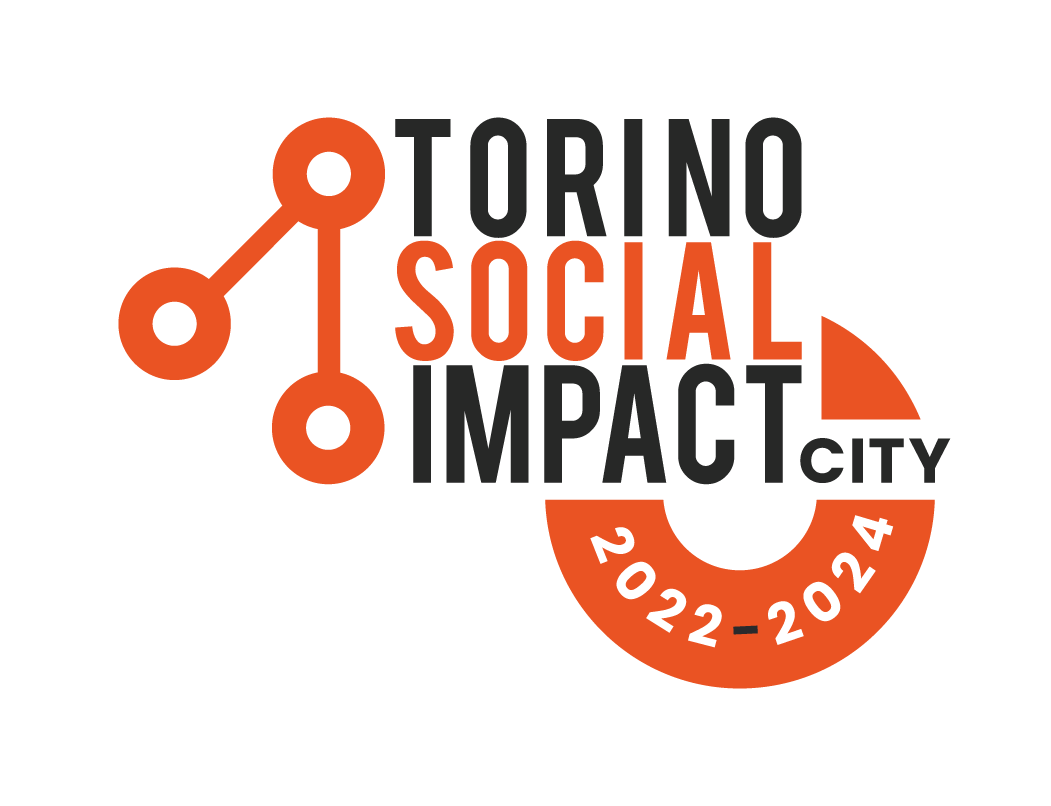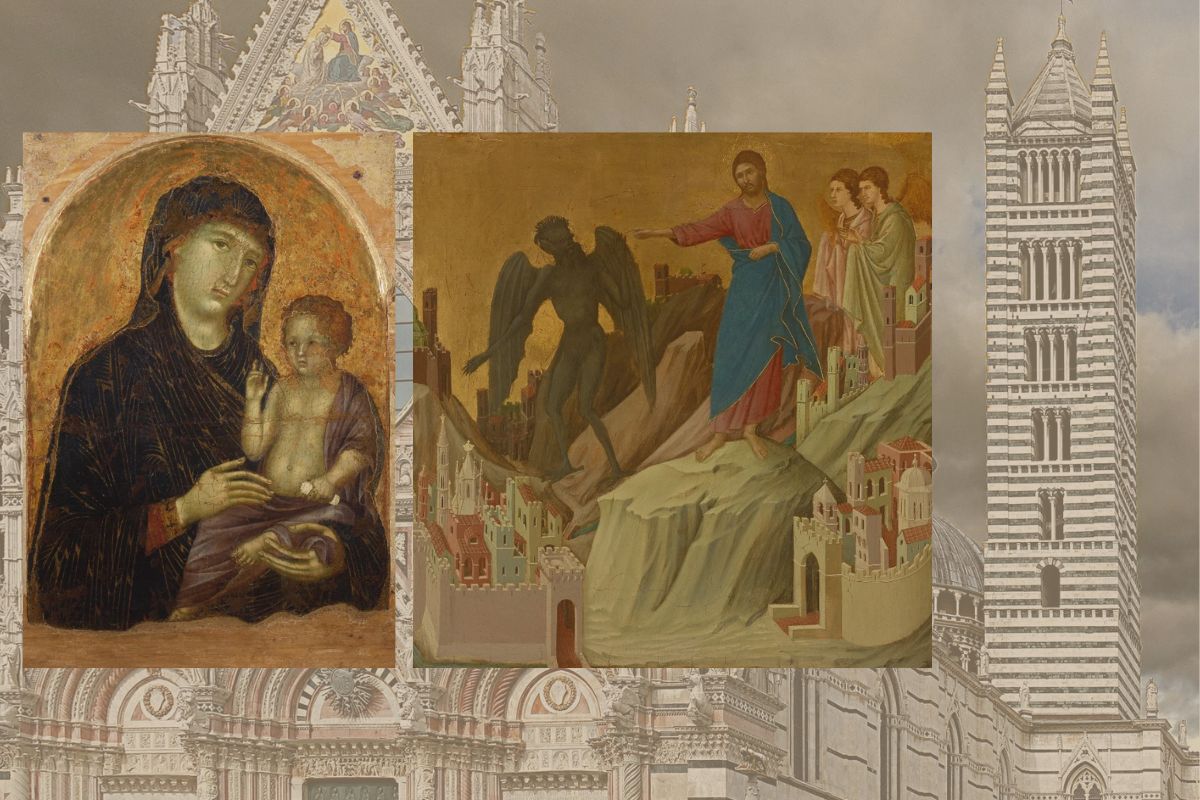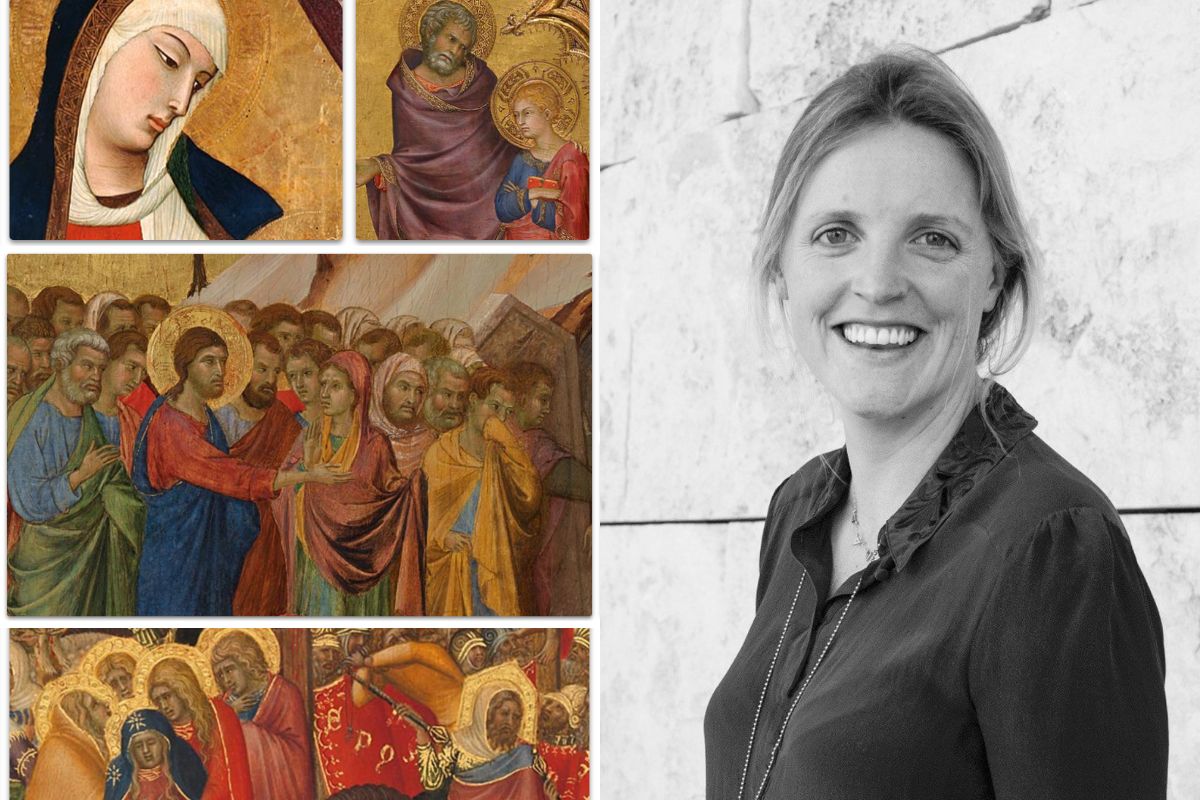
There are still a few more weeks to discover Siena: The Rise of Painting, 1300 ‒1350, an exhibition by the National Gallery and The Metropolitan Museum of Art, which takes place in London until June 22. With over a hundred exhibits created by artisans from Siena, Naples, Avignon, and beyond, the exhibition showcases a golden moment in art. Artists Duccio, Simone Martini, and the brothers Pietro and Ambrogio Lorenzetti are forging a new way of painting.
The leading exhibition’s highlight is the Maestà: after centuries of separation, scenes that once formed part of Duccio’s monumental altarpiece are reunited in London.
This marked the beginning of Hypercritic’s conversation with curator Laura Llewellyn, which focused on artworks, historical context, curatorial vision and process, audience, and impact.
- Reuniting Duccio’s Maestà after centuries of separation
- Duccio at the height of his powers
- Bringing Duccio’s work together: the challenge and goals
- Transportation and conservation
- Studying and researching
- When artworks are divorced from their original context
- Siena VS Florence: What is their role in art history?
- Duccio or Giotto, who is the best narrator?
- Why the title The Rise of Painting?
- The Siena legacy on Western painting
Reuniting Duccio’s Maestà after centuries of separation
“A major ambition of the exhibition was to reunite the eight known surviving panels from the back of Duccio’s Maestà – Llewellyn explains – that’s the section of the altarpiece that has long since been dispersed. Much of the rest, of course, has been retained in Siena, thank goodness. But the opportunity to bring that section of the altarpiece together wasn’t for us, it wasn’t just about the coup, you know, the, the marketing value or the excitement that you can generate from saying that this is a first, and this is a once-in-a-lifetime opportunity, and this hasn’t happened since the 18th century. But really, the chance to experience those works altogether and to start to think about how sophisticated Duccio was in conceiving the sequence and how the episodes relate to one another”.
“This is not work that scholars haven’t done. There are books and studies of how Duccio excels as a painter of narrative. Still, there is nothing that compares to the experience of actually having them all in one space and being able to experience them at the sort of height that they might have been viewed at originally and in the sequence that they were initially intended to be”.
Duccio at the height of his powers
There are also technical aspects to the artwork that enhance our appreciation of Duccio’s mastery even further.
“In the Maestà – dr. Llewellyn adds – the carpentry was completed entirely before the painting began, unlike later polyptics, where you may have numerous individual panels around the workshop that you then bring together in a framework, with battening, etc., on the altar once the whole thing is complete. On the contrary, the Maestà was painted on an existing structure, an enormous architectural body which would have been in Duccio’s workshop. And so inevitably, he would have painted it top to bottom. That’s just a practical thing, you know, because if you’ve already painted the bottom scenes, and then you’re climbing on scaffolding and ladders, etc., you’re going to damage the lower sections, and you may, you know, have paint flying everywhere, or, goodness knows”.
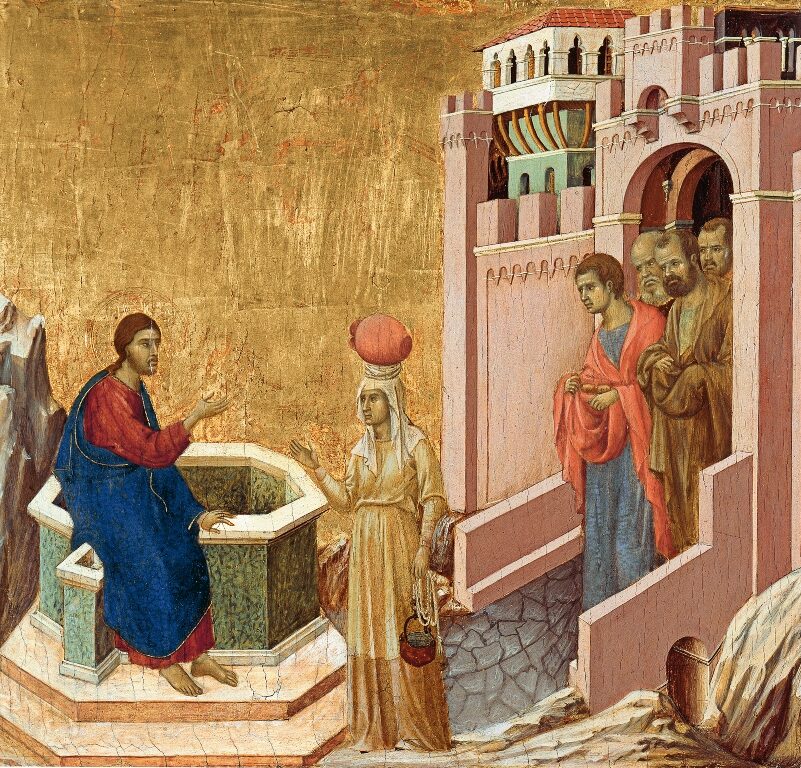
“So, with the back pradella, what we’re looking at is not just an element long since dispersed, but also probably the element that you painted last, and therefore, in a way, an opportunity to witness Duccio at the height of his powers. Duccio, who’s really sort of ironed out the creases in terms of his abilities as a narrative painter. And so these are some of the most sophisticated and impressive narrative episodes in the whole instruction”.
Bringing Duccio’s work together: the challenge and goals
The exhibition is a partnership with the MET in New York and the National Gallery in London. What’s truly significant about this collaboration is the strength of the existing collections in both institutions. The exhibition grows organically out of these two collections.
“In London – Llewellyn explains – we’re fortunate to have three panels by Duccio, two of which come from the predella. Alongside Siena, we are the major holders of works from this dispersed masterpiece. The desire to reunite the predella was one of our first objectives. Once we had accomplished that, we could approach other museums and institutions, saying, ‘This is what the exhibition will look like, and this is its heart.’ That helped to convey the ambition behind the project”.
“When you’re in conversation with colleagues at other museums about borrowing works, it’s always about scholarly value. Artworks should only be lent if there’s a clear contribution to knowledge and understanding. It was essential to communicate that this wasn’t just a display, but a project grounded in scholarship—both new and established—brought together for the first time in a major exhibition format”.
Transportation and conservation
Again, logistics and safety had to be taken into account very seriously.
“We’re in a very different place now, in 2025, compared to 20 years ago – Llewellyn explains – Back then, it might have been unthinkable to transport fragile panel paintings. Today, thanks to scientific and conservation advancements, such as crate technology and climate stabilization, we’ve gained new confidence in safely moving these early works. Much of what we’ve achieved, especially the reunification of Duccio’s predella and other major panel paintings, was made possible by these technological improvements”.
Our conversations weren’t just with curators or directors—they always involved conservators, and often began with them. Conservation was a central part of the process.
Studying and researching
Regarding research and restoration, Dr. Llewellyn says that much of the deeper study will occur after the exhibition. “When works arrive, they’re installed with a courier present, and the focus is on display. But the research doesn’t end there. For us, the exhibition is an extension of the research process. It gives us a chance to keep asking questions while the works are together in the same space”.
“Our science team is already examining several panels. For instance, there’s ongoing work on punchwork—the decorative tooling used in gilded panels—to identify specific tools and workshops, and to understand how new technology can advance that field of study. Our aim is not only to produce the exhibition catalogue, but also to publish a future National Gallery Technical Bulletin focused on Sienese art, where many of these findings will be shared in depth”.
When artworks are divorced from their original context
Many of the pieces in the Siena exhibition were conceived as devotional objects to be held in the hand, taken on the road, or, in the case of larger altarpieces, as works designed for specific architectural settings — objects you could walk around, that operate as much like architecture as they do as painting. We asked Dr. Llewellyn what the audience gains and loses by seeing such artworks showcased in a gallery.
“That experiential side is inevitably lost when we move these works into a gallery context – she replied – But the gallery also offers certain advantages. For instance, we can light the works with great sensitivity, and visitors can get incredibly close to them. In this exhibition, we’ve emphasized that closeness. Many of the works are displayed in free-standing cases that allow visitors to walk around them, approach them from different angles, and spend time examining them. We wanted to encourage not just close looking, but prolonged looking“.
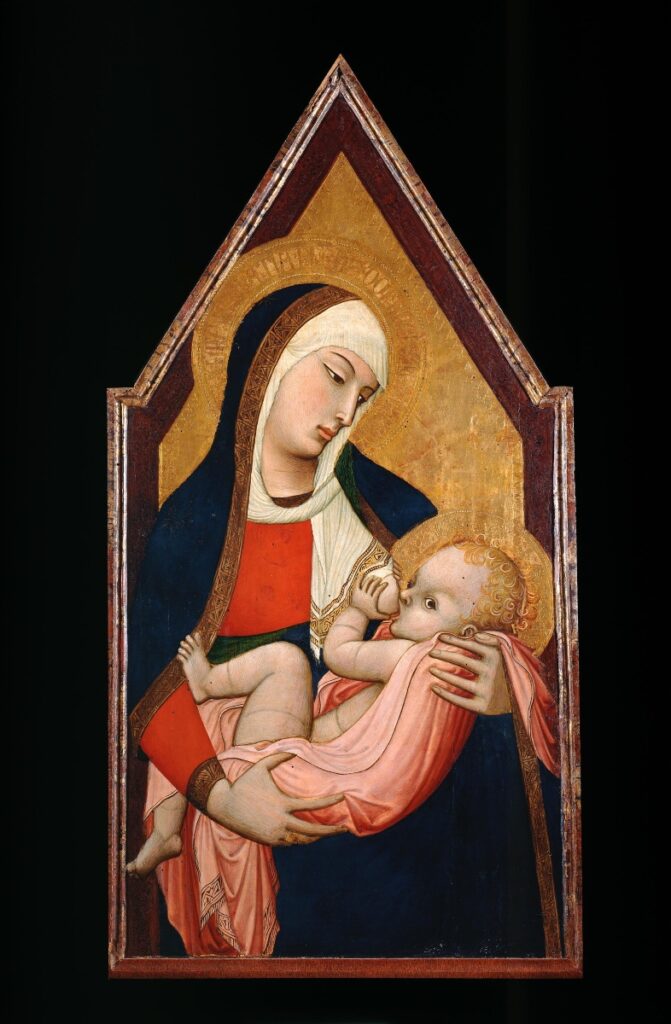
“One of our key ideas was that the presence of the viewer activates these works. This isn’t meant to be a passive experience. The art is designed to make you feel and think. The questions you ask of the painting become a way to access it on many levels. Of course, there are compromises. The gallery in London, for instance, has a very low ceiling, and we had to display the magnificent Talenti polyptych, a monumental altarpiece meant to be viewed from below, at eye level. But even that had surprising benefits — visitors can now stand directly in front of the figures and see that they’re almost life-size. This interaction gives a new sense of their fullness and monumentality, something you might not feel in a church setting”.
Siena VS Florence: What is their role in art history?
Within scholarly circles—among art historians—there’s never really been any doubt about the importance of Sienese painting. But when it comes to public perception, especially among non-specialists, the dominant narrative—essentially a Vasarian one—still tends to position Florence as the undisputed origin of the Renaissance. In what way does the London exhibition help re-establish the role of Siena’s art as a Renaissance driver?
“Of course, we’re not denying Florence’s major role – Dr. Llewellyn explains – The painting that developed in Florence during the late 13th and early 14th centuries was undeniably crucial to the evolution of Western art. But what we are trying to do is complicate that narrative—to showcase the achievements of the Sienese painters and move the broader public away from a simplistic, linear story of progress where one city hands the baton to the next. The reality is much more nuanced, and sticking to a single line of progression does a disservice to the diversity of contributions made by different urban centers”.
“It’s also important to remember that during the period the exhibition focuses on—1300 to 1350—artists like Duccio and the Lorenzetti brothers were being invited to Florence to work on commissions. The reverse isn’t true; Florentine painters weren’t being summoned to Siena. That’s quite telling. Where Sienese painters truly excelled, and gained a reputation far beyond their city, was in the production of monumental polyptychs. When major religious institutions or mendicant orders wanted something spectacular for their high altars—with all the grandeur and symbolism—they consistently turned to the artists of Siena. And that says a lot”.
Duccio or Giotto, who is the best narrator?
Both Duccio and Giotto have a distinct approach to using painting as a powerful tool to convey stories. Who is the best narrator among them? Do they share anything in common, and what are their main differences?
“I think the question of Giotto and Duccio is an interesting one, because they don’t seem to be in dialogue in the same way that Duccio and Cimabue clearly are – Dr. Llewellyn explains – When Duccio arrives in Florence, there’s not just him looking at Cimabue, but also the other way around. On a basic level, Giotto is the king of fresco painting, whereas Duccio reigns supreme in panel painting. That’s a simple way to frame their contributions. But in terms of narrative, both artists share an interest in the human drama. They strip away existing iconographic traditions and theological layers to focus on the episodes they depict in terms of raw human experience”.
So, what does it actually feel like to mourn? Whether it’s the death of St. Francis or the Virgin at the foot of the cross mourning her son, both artists reach for the most fundamental human emotions: grief, pain, love, sadness, and parental affection.
“Where Duccio really stands out – Llewellyn adds – is in his use of color. One aspect we explore in the exhibition is his dialogue with works in other media—especially from Siena—and our strong belief is that Duccio closely observed the work of goldsmiths. These artisans used translucent enamels in brilliant colors through a refined technique known as basse-taille, and Duccio seemed deeply inspired by their color sensibility. Duccio’s brilliance lies not only in his technical ability to create vibrant colors, but also in how he pairs them—how they sit next to one another, reflect one another, and heighten each other’s beauty”.
Why the title The Rise of Painting?
Dr. Llewellyn concludes with a reflection on the exhibition’s title. “We debated this for quite some time – she reveals – Early on, we considered The Invention of Painting, though we always knew it wasn’t right. It’s not that the physical act of painting was invented in this period—clearly, it wasn’t—but rather that painting as an art form was rising in both prestige and ambition“.
“Painting began to outshine other art forms, and painters themselves started to pursue new depths—psychological, emotional, even intellectual. Painting became monumental not just in size, but in impact. It became a space that could stimulate both feeling and thought. Ambrogio Lorenzetti exemplifies this, not only engaging viewers emotionally but also prompting them to think more deeply”.
The Siena legacy on Western painting
“This rise in the status of painting brought with it a rise in the status of painters. That’s why we end the exhibition not in Siena, but in Avignon, with Simone Martini. Siena, after all, was incredibly well connected—positioned on the Via Francigena, a major pilgrimage and trade route linking Northern Europe to Rome. Even though the papal court had moved to Avignon, many high-ranking church officials still traveled regularly to Rome, passing through Siena. These figures encountered Siena’s artists and carried those impressions far beyond the city. So this isn’t just the story of an art form in one place—it’s about how Sienese art traveled, influenced, and reshaped visual culture across Europe“.
“Simone’s presence in Avignon is key to understanding how these Sienese innovations influenced the broader trajectory of Western painting—especially in France and Northern Europe. Even after his death, his work remained visible and influential within the papal court, where dignitaries and clerics would see it, remember it, and sometimes take it back with them in various forms. At the Met, they close their show with a stunning Bohemian Madonna and Child; we conclude with the Wilton Diptych. Both works show how far the reach of Sienese painting extended in this period”.

